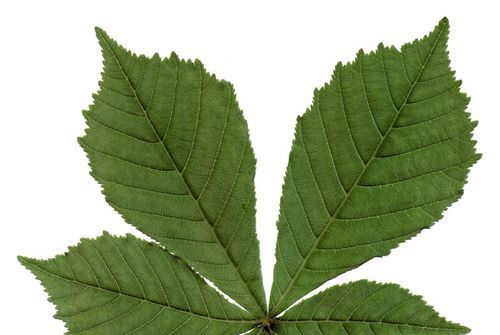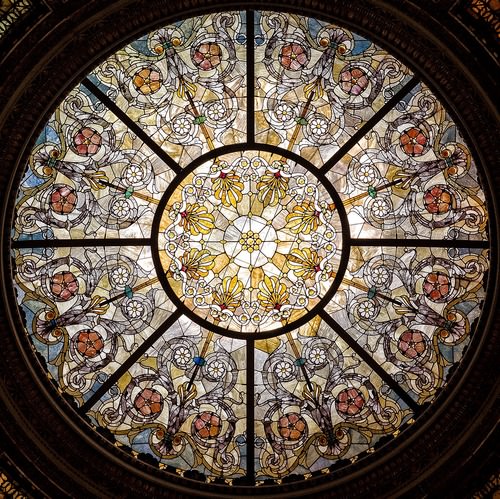19.4 光和颜色
Section outline
-
This rainbow contains all the colors that you can see in the land below it—the yellow of the hills, the green of the leaves and grasses. It contains other colors as well. In fact, a rainbow contains all of the colors of visible light .
::这个彩虹包含所有你可以看到的颜色 在它下面的陆地上—— 山上的黄色,叶子和草的绿色, 也包含其他颜色。事实上,彩虹包含所有可见光的颜色。Wavelength and Color
::波长和颜色Visible light has that can be detected by the human eye. The wavelength of visible light determines the color that the light appears. As shown in the Figure , visible light with the longest wavelength appears red, and the shortest wavelength appears violet. In between are all the other colors of light that we can see. Only seven main colors of light (red, orange, yellow, green, blue, indigo, and violet) are represented in the diagram.
::可见光可以通过人类眼睛探测到。可见光的波长决定光的颜色。 如图所示,可见光的波长最长的亮度显示为红色,最短波长的亮度显示为紫色。介于两者之间的是我们能够看到的所有其他光的颜色。在图表中,只有七种主要光色(红、橙、黄、绿、绿、蓝、英迪戈和紫色)是代表的。The order of colors in visible light, from longest to shortest wavelength, can be remembered using ROY G BIV because the first letter of each color spells out “ROY G BIV.” Separating Colors of Light
::灯光分隔颜色A prism, like the one in the Figure , can be used to separate visible light into its different colors. A prism is a pyramid-shaped object made of transparent matter, usually clear glass or plastic. Matter that is transparent allows light to pass through it. A prism transmits light but slows it down. When light passes from air to the glass of the prism, the change in causes the light to change direction and bend. Different wavelengths of light bend at different angles. This makes the beam of light separate into light of different wavelengths. What we see is a rainbow of colors.
::棱晶像图中的棱晶一样,可以用来将可见光分解成不同的颜色。棱晶是一个由透明物质组成的金字塔形物体,通常是清晰的玻璃或塑料。透明物质允许光穿过它。棱晶传递光,但减慢光速。当光从空气传到棱晶的玻璃时,光的变化会改变方向和弯曲。不同角度的光弯曲波长不同。这使得光的光束分离成不同波长的光线。我们看到的是彩色的彩虹。Q: Look back at the rainbow that opened this article. Do you see all the different colors of light, from red at the top to violet at the bottom? What causes a rainbow to form?
::问题:回顾一下打开这篇文章的彩虹。 你是否看到从顶部红色到底部紫罗兰的所有不同颜色的光线? 是什么导致彩虹形成?A: Individual raindrops act as tiny prisms. They separate sunlight into its different wavelengths and create a rainbow of colors.
::A: 个别雨滴作为微小棱镜作用。 它们将阳光分解成不同的波长, 并创造彩虹颜色。Launch the PLIX Interactive below to observe the of white light through a prism. You can adjust the angle of the white light shining on the prism and observe its effect on how each color of light refracts (or bends):
::启动下面的 PLIX 交互式互动, 通过棱镜观测白光。 您可以调整光照在棱镜上的白光角度, 并观察其对每个光折射( 或弯曲) 的颜色的影响 :Colors of Objects
::对象颜色An opaque object is one that doesn’t let light pass through it. Instead, it reflects or absorbs the light that strikes it. Many objects, such as the leaves pictured in the Figure , reflect just one or a few wavelengths of visible light and absorb the rest. The wavelengths that are reflected determine the color that an object appears to the human eye. For example, the leaves appear green because they reflect green light and absorb light of other wavelengths.
::一个不透明的物体是不能让光穿透它的物体。 相反,它反射或吸收撞击它的光。 许多物体,如图中图画的叶子,只反映一或几波长的可见光并吸收其余的光。 所反映波长决定了物体在人眼中出现的颜色。 例如,叶子看起来绿色,因为它们反映绿色光,吸收其他波长的光。A transparent or translucent material, such as window glass, transmits some or all of the light that strikes it. This means that the light passes through the material rather than being reflected by it. In this case, we see the material because of the transmitted light. Therefore, the wavelength of the transmitted light determines the color that the object appears. Look at the beautiful stained glass windows in the Figure . The different colors of glass transmit light of different colors.
::透明或半透明材料,如玻璃窗,可以传递点火的部分或全部光。这意味着光穿过材料,而不是被其反射。在此情况下,我们看材料是因为传送的光。因此,传送光的波长决定了物体出现的颜色。看看图中美丽的彩色玻璃窗。不同的玻璃颜色传递不同颜色的光。The color of light that strikes an object may also affect the color that the object appears. For example, if only blue light strikes green leaves, the blue light is absorbed and no light is reflected.
::撞击对象的光的颜色也可能影响对象显示的颜色。例如,如果只有蓝光撞击绿叶,则蓝光被吸收,没有光被反射。Q: What color do you see if an object absorbs all of the light that strikes it?
::问题:如果一个物体吸收所有撞击它的光线,你会看到什么颜色?A: When all of the light is absorbed, none is reflected, so the object looks black. But black isn’t a color of light. Black is the absence of light.
::甲:当所有的光被吸收时,没有反射,所以物体看起来是黑色的。但黑色不是光的颜色。 黑色是光的缺失。The Colors We See
::我们看到的颜色The human eye can distinguish only red, green, and blue light. These three colors are called the primary colors of light. All other colors of light can be created by combining the primary colors. Look at the Venn diagram . Red and green light combine to form yellow light. Red and blue light combine to form magenta light, and blue and green light combine to form cyan light. Yellow, magenta, and cyan are called the secondary colors of light. Look at the center of the diagram, where all three primary colors of light combine. The result is white light.
::人类的眼睛只能辨别红色、 绿色和蓝色的光。 这三种颜色被称为光的主要颜色。 所有其他的光的颜色都可以通过合并主要颜色来创建。 看看文恩图。 红光和绿光组合成黄色光。 红光和绿光组合成紫红光, 蓝光和绿光组合成青色光。 黄色、 紫红色和青色被称为光的次要颜色。 看看图表的中心, 所有三种光的主要颜色组合在一起。 结果就是白光 。Have you ever wondered why we see the colors we do? Watch the video below to discover more about the science behind visible colors :
::你有没有想过我们为什么看到我们的颜色?看看下面的视频,Pigments
::颜料Many objects have color because they contain pigments. A pigment is a substance that colors materials by reflecting light of certain wavelengths and absorbing light of other wavelengths. A very common pigment is the dark green pigment called chlorophyll, which is found in plants. Chlorophyll absorbs all but green wavelengths of visible light. Pigments are also found in many manufactured products. They are used to color paints, inks, and dyes. Just three pigments, called primary pigments, can be combined to produce all other colors. The primary colors of pigments are the same as the secondary colors of light: cyan, magenta, and yellow.
::许多物体都有颜色, 因为它们含有色素。 色素是一种物质, 它通过反映某些波长的光和吸收其他波长的光来颜色材料。 一种非常常见的色素是植物中的黑色绿色色素, 叫做叶绿素。 青霉素吸收了可见光的绿色波长。 色素也在许多制成品中找到。 颜料用于涂料、 墨水和染色。 只有三种色素, 叫做初级色素, 可以结合来产生所有其他颜色。 色素的主要颜色与光的次要颜色相同: 青、 紫色和黄色。Q: A color printer needs just three colors of ink to print all of the colors that we can see. Which colors are they?
::问题:一个彩色打印机只需要三个墨水颜色来打印我们可以看到的所有颜色。它们是什么颜色?A: The three colors of ink in a color printer are the three primary pigment colors: cyan, magenta, and yellow. These three colors can be combined in different ratios to produce all other colors, so they are the only colors needed for full-color printing.
::A:彩色打印机中墨水的三种颜色是三种主要颜料颜色:青色、红红色和黄色。这三种颜色可以以不同比例组合,以产生所有其他颜色,因此它们是全色打印所需的唯一颜色。What color would a white car appear under yellow light? What would you see when you look at an orange car through green glasses? Why? Use the sliders in the Rose-Colored Glasses simulation below and play around with setting different colors for the light source, the car, and the glasses to answer these questions and learn more about the :
::白色汽车在黄色灯光下会出现什么颜色? 当你通过绿色眼镜看橙色汽车时你会看到什么颜色? 为什么? 使用下面玫瑰色玻璃模拟的滑胶片, 并给光源、汽车和眼镜设定不同的颜色来回答这些问题,Summary
::摘要-
The wavelength of visible light determines the color that the light appears. Light with the longest wavelength appears red, and light with the shortest wavelength appears violet. In between are the wavelengths of all the other colors of light.
::可见光的波长决定着光的颜色。 最长波长的光显示红色,最短波长的光显示紫罗兰。 中间是所有其他光色的波长。 -
A prism separates visible light into its different colors. As light passes through the prism, it slows and bends, but different wavelengths bend at different angles. This separates light into different wavelengths, forming a rainbow of colors.
::棱晶将可见光分解为不同的颜色。 当光穿过棱晶时,它会减慢和弯曲,但不同的波长会在不同角度弯曲。 它会将光分为不同的波长,形成彩虹。 -
The wavelengths of visible light that an object reflects or transmits determine the color that the object appears to the human eye.
::物体反射或传输的可见光波长确定物体在人眼中的颜色。 -
The human eye can distinguish only red, green, and blue light. These three colors are the primary colors of light. All other colors of light can be created by combining the primary colors. Secondary colors of light—cyan, yellow, and magenta—form when two primary colors combine equally.
::人类的眼睛只能区分红色、绿色和蓝色的光。 这三种颜色是光的主要颜色。 光的所有其他颜色都可以通过将主要颜色结合起来来创造。 光的次要颜色—— 青色、黄色和红红色—— 是两种主要颜色同等结合的次要颜色。 -
Pigments are substances that color materials by reflecting light of certain wavelengths and absorbing light of other wavelengths. The primary pigment colors are cyan, yellow, and magenta. They can be combined to produce all other colors.
::色素是反映某些波长光和吸收其他波长光的颜色材料。 主要的色素颜色是青色、黄色和黄紫色。 它们可以结合以产生所有其他颜色。
Review
::回顾-
What determines the color of visible light?
::什么决定可见光的颜色 ? -
Which color of light has the longest wavelength? Which color has the shortest wavelength?
::哪个颜色的光有最长的波长?哪个颜色的波长最短? -
How does a prism separate visible light into its different colors?
::棱镜如何将可见光分解成不同颜色? -
To a person with normal vision, the apple in the
Figure
appears green. Explain why.
::对于有正常视力的人来说,图中的苹果是绿色的,请解释原因。
-
The human eye can detect only three colors of light. What three colors are they? How can we perceive other colors of light?
::人类的眼睛只能探测到三种光的颜色。什么是三种颜色?我们如何看待其他的光的颜色? -
What are pigments? Identify the primary colors of pigments. If you combined the three primary pigment colors, what color would you get?
::颜料是什么? 识别颜料的主要颜色。 如果您结合了三种基本颜料的颜色, 你会得到什么颜色 ?
-
The wavelength of visible light determines the color that the light appears. Light with the longest wavelength appears red, and light with the shortest wavelength appears violet. In between are the wavelengths of all the other colors of light.






